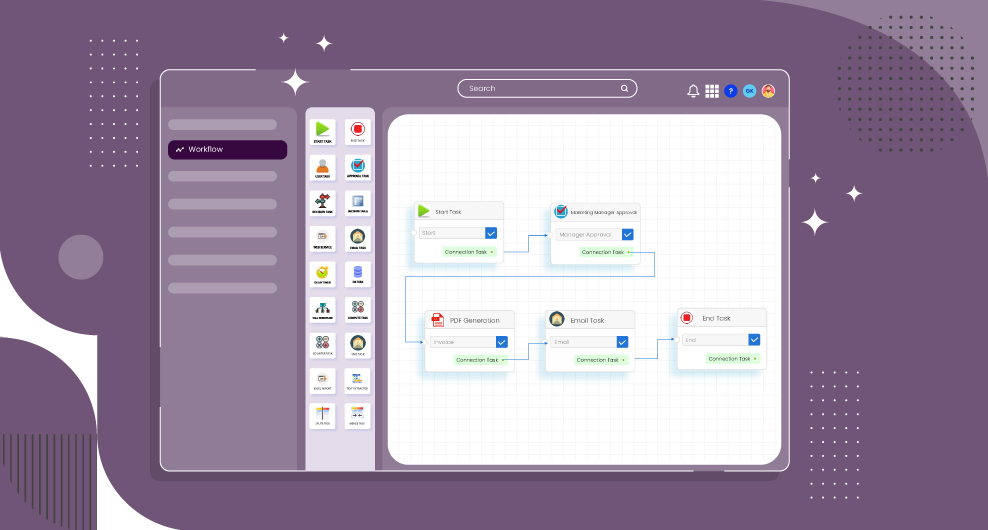Table of Contents
Modern businesses are inundated with countless processes spanning multiple departments. Consequently, many organizations resort to a patchwork of disparate tools and technologies to manage these processes, often resulting in technical debt and shadow IT.
In the quest for process automation, it’s crucial to select tools that can comprehensively address your organization’s needs. However, navigating the crowded automation market and differentiating between similar products can be challenging.
Discover why low-code development stands out as the optimal solution for enabling end-to-end process automation.
What is end-to-end process automation?
End-to-end process automation refers to the automation of a complete business process, from start to finish, without the need for manual intervention. This automation encompasses all the steps and tasks involved in the process, ensuring seamless flow and minimal human involvement.
End-to-end automation can involve various technologies, such as robotic process automation (RPA), workflow automation, and business process management (BPM) software. By automating the entire process, organizations can improve efficiency, reduce errors, and free up resources for more strategic tasks.
Automation and governance
Automation and governance are two key aspects of managing processes within an organization.
Automation involves using technology to perform tasks and processes with minimal human intervention. This can include tasks such as data entry, report generation, and workflow management. Automation can help streamline operations, reduce errors, and increase efficiency.
Governance, on the other hand, refers to the policies, procedures, and controls that are put in place to ensure that processes are carried out effectively, efficiently, and in compliance with regulations and standards. Governance helps organizations manage risk, ensure accountability, and maintain transparency.
When it comes to automation and governance, it’s important to strike a balance. While automation software improves efficiency and reduce costs, it also needs to be governed to ensure that it is being used appropriately and in accordance with organizational policies and regulations. This may involve implementing controls, monitoring automation processes, and conducting regular audits to ensure compliance.
More platforms mean more overhead
Automation aims to boost efficiency, but introducing more platforms can prolong the learning curve for these new systems. This delay hampers the realization of the purported time-saving benefits. However, this issue is not just about metrics like time-to-value or return-on-investment. The effort required to learn, update, and maintain multiple tools diminishes their overall value.
Many enterprises employ a mix of low-code, digital process automation, robotic process automation (RPA), and commercial off-the-shelf (COTS) solutions. Automation, especially at the enterprise level, is intricate and dynamic. It’s not a one-time setup; processes evolve to accommodate new workflows and regulatory changes.
Using multiple platforms has several drawbacks:
- Limits code reuse
- Encourages platform specialization
- Creates disparate systems of record
- Lengthens deployment time for feature releases
A tool like Yoroflow establishes a unified source of truth for all enterprise users, fostering collaboration among developers and users. There’s a direct correlation between collaboration opportunities and the number of automation platforms.
A low-code, end-to-end platform enables the creation of flexible solutions rapidly and at scale, while minimizing overhead.
The reality of end-to-end process automation
Making technology decisions is undeniably laborious. Nobody wants to repeatedly tackle the same difficult decisions due to evolving technology. However, this cycle occurs when one-off solutions are consistently applied to individual problem instances.
Processes like free trials, patchworks of non-centralized IT purchases, and shadow IT experiments tend to become indispensable over time. Integrating machine learning or artificial intelligence to orchestrate an adaptable, comprehensive workflow becomes significantly more challenging without using an end-to-end platform.
While process automation is a crucial goal, it is not synonymous with digital transformation. Rather, it serves as a prerequisite—you must automate to take the first step.
An end-to-end low-code development platform opens the door to intelligent automation, featuring AI- and ML-embedded solutions, as just the starting point. Additional benefits include:
- Streamlining processes through collaboration between IT and the business
- Utilizing a single platform for cross-channel applications and process enhancements
- Deploying scalable cloud-native solutions that integrate all core systems and data sources
- Accelerating your business’ time-to-market
Automate with Yoroflow
The vendor market presents a complex landscape where products often overlap, restricting use cases, scalability, and the seamless integration of new technologies.

Yoroflow stands out as an end-to-end low-code process automation solution designed to support your organization’s long-term evolution. Its customizability and promotion of business-IT collaboration set it apart from a traditional a la carte development and automation environment.




